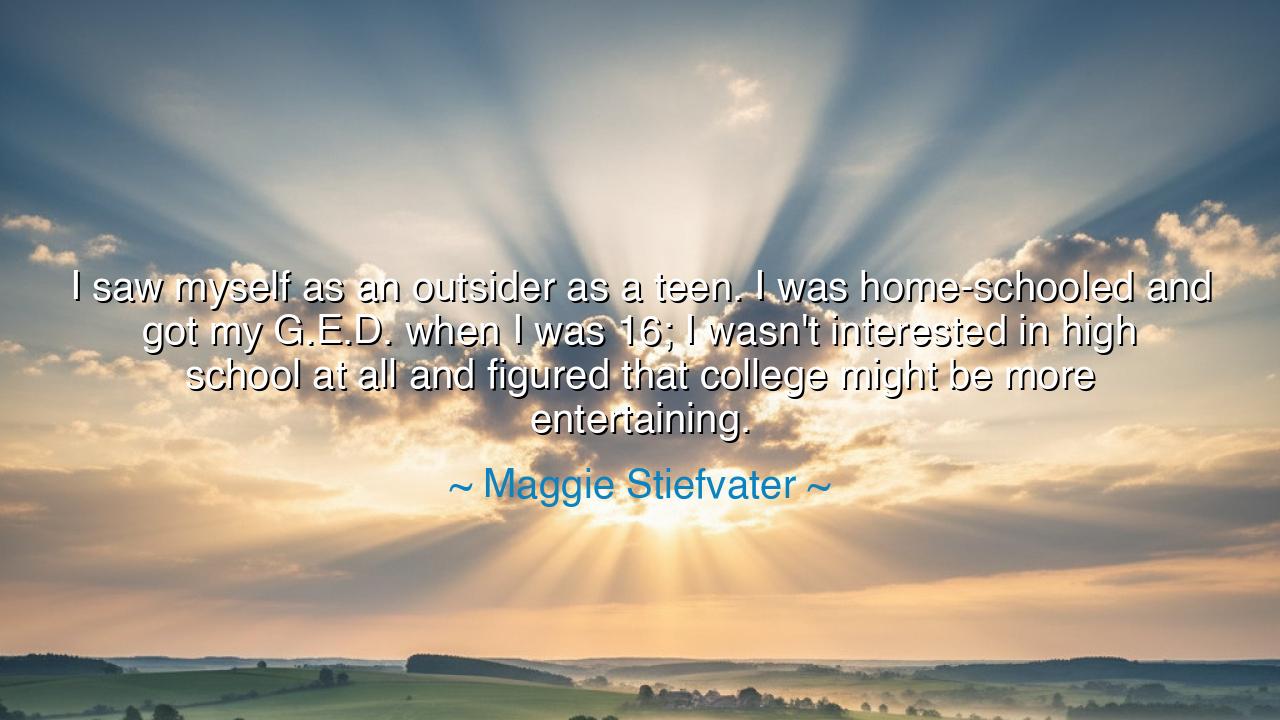
I saw myself as an outsider as a teen. I was home-schooled and
I saw myself as an outsider as a teen. I was home-schooled and got my G.E.D. when I was 16; I wasn't interested in high school at all and figured that college might be more entertaining.






Maggie Stiefvater once reflected: "I saw myself as an outsider as a teen. I was home-schooled and got my G.E.D. when I was 16; I wasn't interested in high school at all and figured that college might be more entertaining." In these words, she reveals the eternal tension between the outsider and the crowd, between the spirit that does not conform and the world that expects conformity. To be young and to step apart from the patterns of the many is often seen as rebellion, yet in truth it is the seed of originality, the soil from which a unique vision may spring forth.
The origin of this statement is woven into Stiefvater’s own life as a writer, musician, and artist. Her youth did not follow the path trodden by most; she chose a different rhythm. Instead of enduring the rituals of high school, she found her way through home-schooling, sought independence, and claimed her G.E.D. at sixteen, leaping ahead into the promise of college. It was not contempt for learning, but a hunger for a kind of learning that matched her restless and imaginative nature. In her decision, she embodied the ancient spirit of those who forge their own trails rather than walk the roads paved by others.
History has known many such outsiders. Consider Leonardo da Vinci, a child born illegitimate, denied the standard path of formal education, yet one who through self-study and relentless curiosity surpassed the scholars of his day. He too was disinterested in conventional schooling, preferring to let the world itself be his classroom. What society considered a hindrance became his advantage, for it freed his mind from rigid molds and allowed him to see connections others could not. In Stiefvater’s journey we glimpse the same truth: that the outsider may, by leaving the crowd, find the wider horizons of creativity.
Her words also remind us that disinterest is not the same as apathy. She was not uninterested in knowledge, but in the cage-like structure of high school life. Many souls hunger for deeper waters but are forced to sip from shallow streams. To step away from what does not nourish you is not weakness, but strength. It is the recognition that time is precious and that growth must be pursued where it is most alive. In choosing college over high school, she revealed the wisdom of seeking a place where learning might once again become an adventure.
Yet there is courage in this path. To call oneself an outsider is to bear loneliness, for the crowd seldom looks kindly upon those who refuse its ways. But it is often the lonely path that leads to the mountaintop. The prophets, the inventors, the poets—all were called outsiders before they were honored as visionaries. The voice that does not blend with the chorus may one day sing the song the world most needs to hear.
For us, the lesson is clear: if you find yourself disinterested in the ordinary, do not mistake it for failure. Instead, recognize it as the whisper of your soul calling you elsewhere. Do not fear if you walk apart, if your steps seem strange, if your path diverges. To be an outsider is not to be lost; it is often to be on the way to something greater.
Therefore, children of tomorrow, take courage from Maggie Stiefvater’s tale. Do not force yourself into molds that do not fit. Seek instead the fields where your spirit may run freely, where learning excites rather than imprisons. If you are an outsider, wear it as a crown, not a curse. For the outsider is often the one who sees what others cannot, and who builds what others never dreamed. Walk your own path, and trust that it will lead you to the place where your difference becomes your strength, and your solitude becomes your power.






AAdministratorAdministrator
Welcome, honored guests. Please leave a comment, we will respond soon